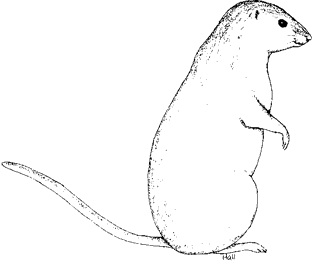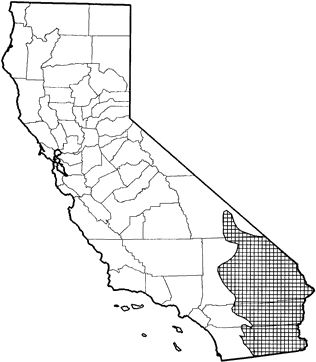
Round-tailed Ground Squirrel
Distribution, Abundance, and Seasonality
The round-tailed ground squirrel is found in desert regions of California from the Mexican border to southern Inyo Co. Optimum habitats are desert succulent shrub, desert wash, desert scrub, alkali desert scrub, and levees in cropland habitat. Also found in urban habitat. Found from -60 to 900m (-180 to 2900 ft) elevation.

Range Map
Specific Habitat Requirements
Feeding: Prefers seeds, leaves, flowers, and other plant parts of grasses, forbs, and shrubs. Green vegetation is in the diet in all months of the year. Will also take insects and spiders. Feeds on the ground surface and climbs in shrubs and trees.
Cover: Burrows at the base of shrubs. Uses levees in agricultural habitats.
Reproduction: Nests are constructed in burrows.
Water: Probably does not require water.
Pattern: Prefers open, flat, grassy areas in fine-textured, sandy soil. A mixture of shrub species is preferred; habitats dominated by creosote bush had fewer squirrels than those without it (Dunford 1977). Prefers sandy soil for hibernation. Density is correlated with winter rainfall. Tends to occur in disjunct populations (Ernest and Mares 1987).
Species Life History
Activity Patterns: Diurnal; hibernates from late August or early September to January or February (Neal 1965b, Dunford 1977). Activity is bimodal in summer, peaking early and late in day, and unimodal in fall and spring, peaking at midday. More active after rain.
Seasonal Movements / Migration: None.
Home Range: Adult home ranges averaged 0.74 ha (1.85 ac) regardless of sex or age. Home range may shift to include preferred foods, but home ranges remain relatively stable for 2, or more, years. Densities varied from 25-225 per ha (10-100 per ac), and are highest when juveniles emerge.
Territory: Adults are territorial, beginning in March. Juveniles become territorial in July or August. At high densities, many individuals may be wounded in territorial disputes.
Reproduction: Mating takes place during late February to March. After a gestation of 27-35 days, the young are born during mid-March to April. The single litter of altricial young averages 6.5 (range 1 -12). Lactation takes place in April to May, and the young are weaned after about 35 days. The young emerge in May, and most males disperse in June. First reproduction takes place in yearlings. Above average winter rain increases the litter size, and additional rains in December and January advance the breeding season (Reynolds and Turkowski 1972).
Niche: Gopher snakes, prairie falcons, and house cats are major predators (Dunford 1977). The range of the round-tailed ground squirrel abuts that of the similar Mohave ground squirrel.
Comments: Populations of S. t. chlorus are restricted to the Coachella Valley, Riverside Co., and are reduced by urbanization, cultivation, and development.
Sources & References
California Department of Fish and Game, 1999.
California's Wildlife, Sacramento, CA.
Written by: G. Hoefler, J. Harris, reviewed by: H. Shellhammer, edited by: S. Granholm
Bradley, W. G. 1968a. Homing in the antelope and round-tailed ground squirrels. J. Ariz. Acad. Sci. 5:22-26. Bradley, W. G. 1968b. Food habits of the antelope ground squirrel in southern Nevada. J. Mammal. 49:14-21. Drabek, C. M. 1973. Home range and daily activity of the round-tailed ground squirrel, Spermophilus tereticaudus neglectus. Am Midl. Nat. 89:287-293. Dunford, C. 1977. Behavioral limitations of round-tailed ground squirrel density. Ecology 58:1254-1268. Ernest, K. A., and M. A. Mares. 1987. Spermophilus tereticaudus. Mammal. Species No. 274. 9pp. Grinnell, J. 1937. Mammals of Death Valley. Proc. Calif. Acad. Sci. 23:115-169. Grinnell, J., and J. Dixon. 1919. Natural history of the ground squirrels of California. Calif. State Comm. Horticulture Bull. 7:597-708. Neal, B. J. 1965a. Reproductive habits of round-tailed and Harris antelope ground squirrels. J. Mammal. 46:200-205. Neal, B. J. 1965b. Seasonal changes in body weights, fat depositions, adrenal glands, and temperature of Citellus tereticaudus and C. harrisii. Southwest. Nat. 10:156-166. Reynolds, H. G., and F. Turkowski. 1972. Reproductive variations in the round-tailed ground squirrel as related to winter rainfall. J. Mammal. 53:893-898.
California Animal Facts | California's Wildlife